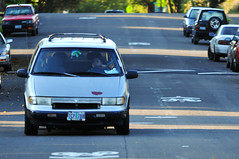The City of Portland has released their draft 2011 Legislative Agenda. As we hinted might happen back in July, that agenda includes an initiative to reduce neighborhood speed limits to a maximum of 20 mph on certain streets.
Mayor Adams has made it clear for a long time that he wants the Bureau of Transportation to have more authority to set local speed limits (currently all speed limits are set by ODOT, but can changed by request). However, instead of looking to make a wholesale transfer of authority, it looks as though PBOT will try to create a blanket law that would set a 20 mph maximum speed limit on all streets designated as “neighborhood greenways” (which is how I suspected they’d go about it; read end of this post published last month).
Here’s the language from the draft legislative agenda:
SPEED LIMITS – Introduce legislation creating a “Neighborhood Greenway” designation that would establish a reduced speed limit of 20 miles per hour (mph) in particular areas where improvements have been made to address bicycle and pedestrian safety.
This method of tying a new law to a specific traffic designation reminds me of how PBOT and the Bicycle Transportation Alliance worked with the Portland Police Bureau on the Vulnerable Roadway User statute. The BTA’s lobbying efforts in Salem helped create the VRU law. Once codified in the Oregon Revised Statutes, the Portland Police Chief was able to create a new traffic investigation threshold tied to that specific designation.
With speed, PBOT will have to take two steps in the legislature. First, they’ll add definition of “neighborhood greenways” into Oregon law and then add an exception into the speed law that specifically calls out a lower limit on neighborhood greenway streets (sort of like specific laws around school zones).
Rob Sadowsky, executive director of the BTA, says reducing speeds on neighborhood greenways is a key piece of the puzzle. “For neighborhood greenways to function as intended, they need to have slower speeds. It’s the missing piece.” Sadowsky also thinks tying lower speed limits to streets where biking is prioritized will help win hearts and minds of people who don’t bike.
“There are a lot of neighborhood folks that’d love to see lower speed limits on their streets. So if this passes, and you want 20 mph limits, then get out and support a neighborhood greenway… This could help us go from people who look at these facilities as bike-specific, to really understanding the connection between livability and traffic calming. That’s exciting because it can build a constituency base we didn’t have before.”
Browse our “speed” story archives for more background on this topic.
The City will hold Town Hall on their Legislative Agenda tomorrow. Details here.


